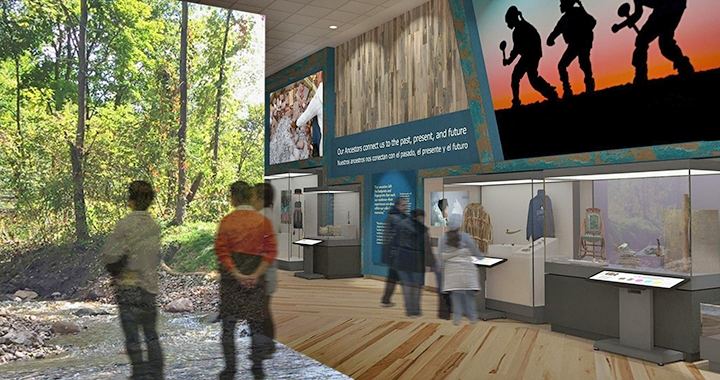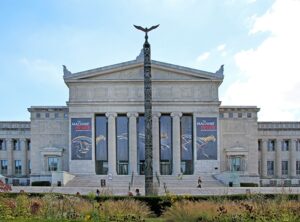
CHICAGO – The debut date of the groundbreaking renovation of the Field Museum’s Native North America Hall has been announced. The museum has also chosen its exhibition title reflecting a new approach to the relationship between Native American communities and museums, the Native land upon which museums were built, and the items in their collections.
Native Truths: Our Voices, Our Stories will open to the public on May 20, 2022. The exhibition was curated by Alaka Wali, PhD, with the guidance of an advisory council of eleven Native American scholars and museum professionals. They worked in partnership with 125 collaborators representing more than 100 tribes.
“The exhibition will feature Native American voices telling their own stories,” says Field Museum Head of Exhibitions Jaap Hoogstraten. “This required the Field Museum to fundamentally change the process of how we co-curate exhibitions with communities.”
Native Truths: Our Voices, Our Stories breaks the mold of a mainstream exhibition and instead of focusing on items, it will be driven by the stories, both historical and current, told by Native American people in their own voices. These stories are supported by recent art, poetry, photography, and historical objects from the museum’s collections. With a special section devoted to the Native community in Chicago, other galleries within the exhibition will rotate over the years. This will provide space for new stories from Native Americans across the United States and Indigenous peoples of Canada.
This exhibition is “as needed as ever”

The exhibition will highlight Native historic and present-day stories of sovereignty, resilience, continuity, and the future. Visitors will have the opportunity to get a close-up look at California basketry practices passed on across generations, experience music-making through the eyes of a young Lakota hip-hop artist, follow the process of Meskwaki efforts to revitalize heirloom and ancestral plants, delve into the history and importance of Chaco Canyon, and visit the Pawnee Earth Lodge in a new context.
Meranda Roberts, PhD (Yerington Paiute), a postdoctoral researcher and one of the co-curators for the exhibition, says she hopes that Native Truths will be a starting point for the Field and the Chicago community to discuss colonization and the ways that Indigenous communities have been harmed, and for Native people to tell their stories on their own terms.
“This exhibition is as needed as ever,” Roberts says. “Our country is at a precipice at thinking about how to come to terms with the horrendous ways it has treated our people, how to address that history, and how to ensure that it never happens again. I think this exhibition does a beautiful job at highlighting the way Native people should be celebrated and talked about in public spaces, like the Field Museum.”
“A vibrant story of resilience and innovation”
Visitors will see items from the Field’s collection like dance regalia and pottery and understand their historical significance, as well as exclusive artwork created especially for this exhibition by Native artists including poetry, music, and murals showcasing their experiences today. Multimedia interactives will showcase unique skills like basket weaving, as well as some of the most pressing current issues Native people face.
“I think visitors will be blown away by the way in which the items from our collection and the contemporary pieces we have borrowed, commissioned or purchased especially for this exhibition seamlessly work together to tell a vibrant story of resilience and innovation in the face of trauma and continuity of knowledge traditions across generations,” says Curator of North American Anthropology Alaka Wali. “This is not a chronology of events, but rather a new and completely different perspective on Native American and First Nations experiences, world views and aspirations.”
Collaborators for the exhibition were intentional in telling Indigenous stories to provide visitors with an understanding of Native American experiences and culture, perhaps righting previously held stereotypes or beliefs.
“For Native visitors, I also hope there is an instant connection. I hope they see themselves, see their relatives, their grandparents, and aunties and uncles,” says Debra Yepa-Pappan (Jemez Pueblo/Korean), the community engagement coordinator for the renovation project. “For non-Native visitors, we’ve been working to make this an immersive experience that allows them to come into our home — learning from us, not just about us. I’m hoping they get a better understanding of Native people and see the humanity in us to start to challenge stereotypical images they may see around the city, and around the country.”
A “new way forward”
The exhibition is the result of months of work and collaboration between Indigenous advisers and artists, as well as the Native and non-Native Field Museum staff, which will set the precedent for future projects.
“I feel really privileged to have worked with such talented curators and developers at the Field over the past three years and to add my voice to the wise and caring Indigenous advisors on this project,” says Patty Loew, PhD (Bad River Ojibwe), a member of the advisory committee. Loew is the director for the Center for Native American and Indigenous Research and a professor in the Medill School of Journalism at Northwestern University.
“I think visitors will really get a true sense of Native truths when they experience this new exhibit,” Loew added.
“With the reimagined Native North American Hall, the Field Museum is breaking new ground and setting precedent for future galleries,” says Field Museum President Julian Siggers. “Working with our Native partners through every part of the exhibition process has not only yielded a rich and rewarding experience for all of us but also established a new way forward for how the Field and other museums work in partnership with living communities.”
